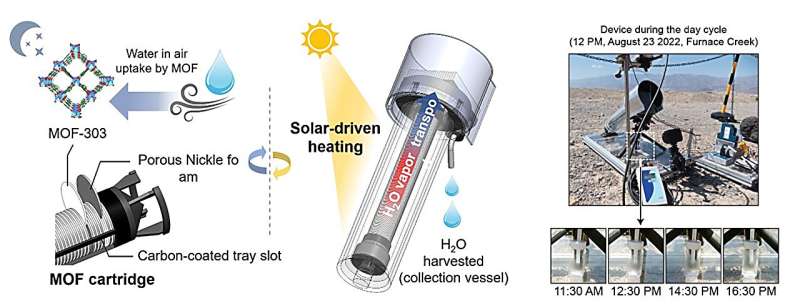This article has been reviewed according to Science X's editorial process and policies. Editors have highlighted the following attributes while ensuring the content's credibility:
fact-checked
peer-reviewed publication
trusted source
proofread
Water harvesting in Death Valley: Conquering the arid wilderness

Korea is regarded as a "water-stressed nation." Although the country receives an annual precipitation of approximately 1,300mm, it is characterized by concentrated periods and specific regions, thereby giving rise to challenges stemming from water scarcity. The lack of drinking water extends beyond mere inconvenience, posing life-threatening implications for certain individuals.
In March 2023, the United Nations Children's Fund (UNICEF) released a report highlighting the plight of roughly 190 million children in Africa who suffer from an absence of safe water, resulting in the tragic daily loss of 1,000 children under the age of five.
Nations across the globe are employing diverse approaches in an endeavor to mitigate this issue. However, seawater desalination is energy intensive that predominantly reliant on fossil fuels engendering environmental pollution such as discharge of concentrated brine into the sea. Harvesting atmospheric water also presents challenges, particularly in regions with humidity is less than 70% as it necessitates a substantial amount of energy to condense the vapor, rendering it an ineffective solution.
Recently, a joint team of researchers led by Professor Woochul Song from the Division of Environmental Science & Engineering at Pohang University of Science and Technology (POSTECH) and Omar M. Yaghi, Professor of Chemistry at UC Berkeley, accomplished successful atmospheric water harvesting using ambient sunlight in the Death Valley desert. The achievement signifies a promising breakthrough in tackling water scarcity as it harnesses an infinite resource without polluting the environment. The research findings were published in the international journal Nature Water .
Metal-organic frameworks (MOFs) refer to porous materials characterized by minuscule holes measuring 1–2 nm. High-surface-areas of MOFs function as an absorbent, capturing atmospheric water vapor. To this end, the research team devised a water harvesting device, which is referred to as water harvester, based on the MOF, leveraging its capability to draw in water from the atmosphere during nighttime while condensing the absorbed water into drinkable liquid using ambient sunlight throughout the day.
The team's water harvester takes the form of a cylindrical structure, unlike conventional rectangular design. This configuration ensures that the device's surface area aligns with the trajectory of the sun, maximizing the utilization of ambient sunlight from sunrise to sunset.
The research team tested the harvester through water collection experiments conducted in two different locations: Berkeley in June 2022 and Death Valley desert in August 2022. Death Valley desert represents one of the world's hottest and most arid regions. With persistently elevated temperatures reaching 40°C even at midnight, soaring to a scorching 57°C during day, and a relative humidity below 7%, the area experiences exceptionally dry conditions.
During the experiments, the device harvested up to 285g and 210g of water per kilogram of MOF in Berkeley and Death Valley desert respectively. This represents a twofold increase in water production compared to the previous harvesters.
Notably, the research team's harvester successfully extracted water without generating any carbon footprint even in the extremely dry weather conditions including the highest temperature of 60°C and the average night humidity of 14%. The team's unique condenser and MOF-absorbent system, empowered the water harvesting process solely through the use of ambient sunlight, rendered additional energy sources or power supplies unnecessary.
The research holds substantial significance due to the experiments conducted in genuinely extreme environments, effectively showcasing the practicality of the technology. The ability to harvest water from atmospheric water vapor has universal applicability, offering contributions toward the realization of ethical objectives in the realms of environment and public health, thereby serving as a pivotal technology for human security.
Professor Woochul Song at POSTECH conveyed explained, "We have substantiated the technology's potential to address the escalating challenges of water scarcity, further compounded by environmental issues." He added, "This technology embodies sustainability as it provides a reliable water resource regardless of geographic or weather conditions in the world."
More information: Woochul Song et al, MOF water harvester produces water from Death Valley desert air in ambient sunlight, Nature Water (2023). DOI: 10.1038/s44221-023-00103-7
Journal information: Nature Water
Provided by Pohang University of Science and Technology





















